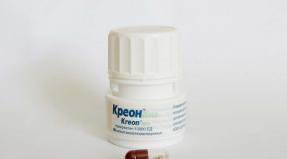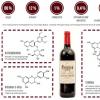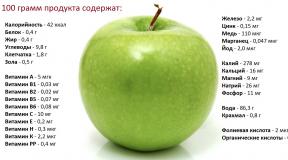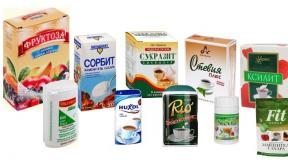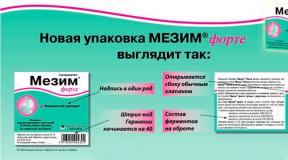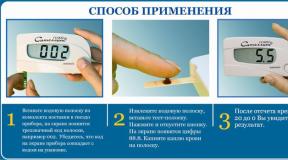Glycemic index of different types of flour
Flour is the final powdery product of grain processing. It is used for making bread, confectionery, pasta and other flour products. For people suffering from diabetes, it is important to know the glycemic index of flour, as well as its types, in order to choose a variety suitable for preparing low-carbohydrate dishes.
What is grinding?
Flour, obtained from the same raw material, but using different processing methods, differs in its grinding:
- Fine grinding - such a product is the result of cleansing the grain from the shell, bran and aleurone layer. It is quickly digestible due to the significant amount of carbohydrates in the composition.
- Medium grind – this type of flour contains fiber from the grain shell. Use is limited.
- Coarse Grind (Whole Wheat Flour) – Similar to ground grain. The product has all the components of the original raw materials. It is most suitable and useful for use with diabetes and a healthy diet.
Approximate composition of flour:
- starch (from 50 to 90% depending on the variety);
- proteins (from 14 to 45%) – wheat has low levels, soybeans have the highest;
- lipids – up to 4%;
- fiber – dietary fiber;
- B-series vitamins;
- retinol;
- tocopherol;
- enzymes;
- minerals.
Several varieties are made from wheat. The highest grade is characterized by low fiber content, the smallest particle size and the absence of grain shells. This product has a high calorie content (334 kcal) and significant glycemic index numbers (85). These indicators classify premium wheat flour as a product whose limitation is an important part of the diet of diabetics.
Premium wheat-based product is an enemy for diabetics
Indicators of other varieties:
- The first is that the particle size is slightly larger, calorie content – 329 kcal, GI 85.
- Second - size indicators are within 0.2 mm, calorie content - 324 kcal.
- Coarse grains – particles up to 0.5 mm, peeled, have a small amount of fiber.
- Wallpaper flour - up to 0.6 mm, unrefined grains are used, so the amount of vitamins, microelements and fiber is significantly higher than previous representatives.
- Whole grain flour - ground unprocessed grains of raw materials, is most useful for both healthy and sick people.
Important! In the diet of type 1 diabetics, the use of whole grain flour is allowed, but not often. In type 2 of the disease, it is better to completely abandon dishes based on wheat flour, since glucose-lowering drugs cannot accurately “block” the amount of carbohydrates supplied, unlike insulin.
Among all the raw materials used to produce oatmeal, oats have the lowest level of carbohydrates (58%). In addition, the grains contain beta-glucans, which lower blood sugar levels and help eliminate excess cholesterol, as well as B-vitamins and microelements (zinc, iron, selenium, magnesium).
Adding oat-based products to the diet can reduce the body's need for insulin, and a significant amount of fiber helps normalize the gastrointestinal tract. The glycemic index is in the average range - 45 units.
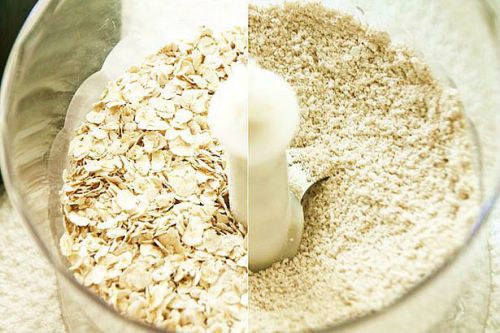
Oatmeal is a product of milling flakes
Possible oatmeal-based dishes for diabetics:
- oat cookies;
- pancakes with maple syrup and nuts;
- pies with sweet and sour apples and oranges.
Buckwheat oatmeal
Buckwheat flour (glycemic index is 50, calorie content is 353 kcal) is a dietary product that allows you to cleanse the body of toxins and waste. Beneficial properties of the constituent substances:
- B vitamins normalize the functioning of the central and peripheral nervous system;
- nicotinic acid removes excess cholesterol and normalizes blood circulation;
- copper is involved in cell growth and differentiation, strengthens the body's defenses;
- manganese supports the functioning of the thyroid gland, normalizes glycemic levels, and allows the absorption of a number of vitamins;
- zinc restores the condition of the skin, hair, nails;
- essential acids provide the needs of energy mechanisms;
- folic acid (especially important during pregnancy) promotes normal fetal development and prevents the occurrence of neural tube abnormalities;
- iron helps increase hemoglobin levels.
Important! We can conclude that the product should be included in the diet of patients with diabetes and people who follow healthy eating rules.
Corn oatmeal
The product has a borderline glycemic index of 70, but due to its composition and many beneficial properties it should be part of the diet of both healthy and sick people. It has high levels of fiber, which has a beneficial effect on the gastrointestinal tract and digestive processes.
Significant amounts of thiamine contribute to the normal course of nervous processes and improve blood supply to the brain. A corn-based product removes excess cholesterol, accelerates the regeneration of cells and tissues, and enhances muscle growth (against the background of significant physical activity).
Rye product
Rye oatmeal (glycemic index – 40, calorie content – 298 kcal) is the most desirable variety for making various types of flour products. This primarily applies to people prone to hyperglycemia. The wallpaper variety contains the greatest amount of nutrients, which is obtained from unrefined rye grains.

A rye-based product is a storehouse of vital vitamins and microelements
Rye flour is used for baking bread, but the content of minerals and vitamins is three times higher than that of wheat, and the amount of fiber is higher than that of barley and buckwheat. The composition includes essential substances:
- phosphorus;
- calcium;
- potassium;
- copper;
- magnesium;
- iron;
- B vitamins.
Flaxseed flour
The glycemic index of flaxseed meal has 35 units, which classifies it as a permissible product. The calorie content is also low - 270 kcal, which is important when using this type of flour for obesity.
Flaxseed is made from flax seed after its oil is extracted by cold pressing. The product has the following beneficial properties:
- normalizes metabolic processes;
- stimulates the functionality of the gastrointestinal tract;
- prevents pathologies of the heart and blood vessels;
- normalizes glycemia and cholesterol levels;
- binds toxic substances and removes them from the body;
- has an anti-cancer effect.
Pea based flour
The GI of the product is low - 35, calorie content - 298 kcal. Pea flour has the ability to reduce the glycemic indicators of other foods when consumed simultaneously. Normalizes metabolic processes, prevents the growth and spread of tumor cells.
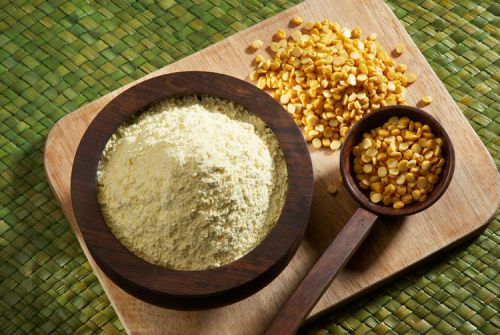
Pea oatmeal is a gluten-free product
The product reduces the quantitative indicators of cholesterol in the blood, is used for diseases of the endocrine system, and protects against the development of vitamin deficiency.
Important! Pea flour is good for making soups, sauces and gravies, pancakes, flatbreads, pancakes, donuts, main courses based on meat, vegetables and mushrooms.
Amaranth flour
Amaranth is a herbaceous plant that has small flowers, native to Mexico. The seeds of this plant are edible and are successfully used in cooking. Amaranth flour is a good substitute for those crushed grains that have high GI values. Its EE index is only 25 units, calorie content is 357 kcal.
Properties of amaranth flour:
- has a large amount of calcium;
- has virtually no fat;
- contains substances that have an antitumor effect;
- Regular consumption of the product allows you to remove excess cholesterol and return blood pressure to normal;
- strengthens the body's defenses;
- allowed for those who cannot tolerate gluten (it is not included);
- considered a powerful antioxidant;
- Helps maintain hormonal balance.
Rice product
Rice flour has one of the highest GI values - 95. This makes it prohibited for diabetics and obese people. The calorie content of the product is 366 kcal.
Rice flour contains all B vitamins, tocopherol, macro- and microelements (iron, zinc, selenium, molybdenum and manganese). The benefits of the product are based on the complete composition of essential amino acids that are necessary for the normal functioning of the human body. In addition, this flour is gluten-free.
A product based on rice raw materials can be used to prepare pancakes, cakes, and a variety of sweets. This flour is not suitable for baking bread; for this purpose it is used in combination with wheat flour.
To obtain such a product, a process of grinding roasted beans is used. Soybean is considered a storehouse of plant protein, iron, B-vitamins, and calcium. On store shelves you can find a whole variety that has retained all the useful components, and low-fat (GI equal to 15). In the second option, the flour contains calcium and protein levels that are an order of magnitude higher.

The low-fat product has the lowest GI among all types of flour.
Product properties:
- lowering cholesterol levels;
- fight against excess weight;
- prevention of heart and vascular diseases;
- anti-cancer properties;
- combating symptoms of menopause and menopause;
- antioxidant.
The soy-based product is used to make buns, cakes, pies, muffins, pancakes and pasta. It is good as a thickener for homemade gravies and sauces, and replaces chicken eggs in properties and composition (1 tbsp = 1 egg).
Awareness about the calorie content, GI and properties of flour based on various raw materials will allow you to select permitted products, diversify your diet, and replenish it with essential nutrients.


